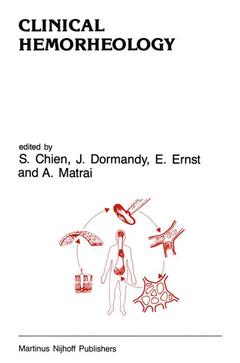Clinical Hemorheology, 1987 Applications in Cardiovascular and Hematological Disease, Diabetes, Surgery and Gynecology Developments in Cardiovascular Medicine Series, Vol. 74
Langue : Anglais
Coordonnateurs : Chien S., Dormandy John A., Ernst E., Matrai A.

The task the editors have set themselves is to survey the field of clinical hemorheology from basic principles to up-to-date research. It is only in a new science like this that it is possible to span the whole field in a book of this size. Hemorheology, as a new approach to the study and management of a wide range of circulatory diseases, is now beginning to appear with increasing frequency in general as well as specialized medical journals. Hemorheology is also just beginning to creep into the undergraduate medical curriculum. Therefore, the majority of graduate doctors are unequipped to assess the place of hemorheology in the overall framework of circulatory physiology and pathology or to assess its relevance to their everyday practice. It is hoped that this book will fill this gap. The approach of the book is interdisciplinary. The first part deals with basic principles of blood flow, circulation and hemorheology. It has been written with the general doctor in mind, who has no special knowledge of hemodynamics and rheological concepts, terminology or methodology. To maintain the emphasis on practical clinical applications, all the chapters in the second part of the book have been written by clinical specialists practicing in the individual areas of disease. The book is so designed that clinicians may be able to read the relevant chapters in the second part of the book in isolation, using the basic science aspects contained in the first part of the book as reference chapters.
1. Introduction: On the way to modern clinical hemorheology.- 2. Biophysics.- 2.1. Basic concepts.- 2.2. Viscometry.- 2.3. Other techniques quantifying blood rheology.- 2.4. Rheology of normal blood.- 2.5. Blood sampling and handling in hemorheological tests.- 2.6. Clinical interpretation of hemorheological data.- 2.7. References.- 3. Rheology of blood cells.- 3.1. Introduction.- 3.2. Dynamic deformability of blood cells.- 3.3. Rheological implications of blood cell deformabilities.- 3.4. Blood cell aggregation - disaggregation and interaction with vascular endothelium.- 3.5. Acknowledgements.- 3.6. References.- 4. Structural, hemodynamic and rheological characteristics of blood flow in the circulation.- 4.1. Introduction.- 4.2. Structural and hemodynamic characteristics of the vascular system.- 4.3. Functional compartments within the vascular system.- 4.4. Blood cell rheology in the circulation.- 4.5. Summary and conclusions.- 4.6. References.- 5. Physiological and pathophysiological significance of hemorheology.- 5.1. The role of hemorheology in circulatory physiology.- 5.2. Circulatory consequences of pathological alterations in blood rheology.- 5.3. Summary and conclusions.- References.- 6. Cardiovascular diseases.- 6.1. Introduction.- 6.2. Myocardial ischemia.- 6.3. Hypertension.- 6.4. Cerebral ischemia.- 6.5. Ischemia of the leg.- 6.6. Raynaud’s phenomenon.- 6.7. Conclusions.- 6.8. References.- 7. Thrombosis and hemorheology.- 7.1. Introduction.- 7.2. Rheology and platelets.- 7.3. Rheology, coagulation and fibrinolysis.- 7.4. Venous thromboembolism.- 7.5. Arterial thromboembolism.- 7.6. Thrombosis of arterial shunts and grafts.- 7.7. Microvascular thrombosis.- 7.8. References.- 8. Hemorheology and blood diseases.- 8.1. Introduction.- 8.2. The pathophysiology ofblood hyperviscosity.- 8.3. The syndrome of polycythemic hyperviscosity.- 8.4. The syndrome of sclerocythemic hyperviscosity.- 8.5. The syndrome of plasmatic hyperviscosity.- 8.6. Summary and conclusions 249 References.- 9. Obstetrics, neonatology and gynaecology.- 9.1. Why rheology in obstetrics, gynaecology and neonatology?.- 9.2. Maternal rheology in normal pregnancy.- 9.3. Normal fetal hemorheology.- 9.4. Pathological pregnancy.- 9.5. Rheology in the neonate.- 9.6. Treatment of neonatal hyperviscosity.- 9.7. Rheological sequelae of oral contraception.- 9.8. References.- 10. Diabetes.- 10.1. Introduction.- 10.2. Diabetes and its complications.- 10.3. Relevance of blood rheology in diabetes.- 10.4. Macrorheology of blood in diabetes.- 10.5. Microrheology of blood in diabetes.- 10.6. Implications.- 10.7. References.- 11. Other syndromes associated with impaired blood flow and rheology.- 11.1. Introduction.- 11.2. Shock.- 11.3. Surgery and anesthesia.- 11.4. Rheumatic disease.- 11.5. Renal disease.- 11.6. Neoplastic disease.- 11.7. Miscellaneous.- 11.8. Summary and conclusion.- 11.9. References.- 12. Hemorheological treatment.- 12.1. Introduction.- 12.2. Hemodilution 330 12.2.1. Forms of hemodilution.- 12.3. Apheresis.- 12.4. Plasma substitutes.- 12.5. Defibrinogenation.- 12.6. Oral drugs.- 12.7. Non-pharmacological approach.- 12.8. Conclusions.- 12.9. References.- 13. Summary, Conclusions and Perspectives.- 13.1. Brief summary.- 13.2. Conclusions.- 13.3. Perspectives.
Date de parution : 10-2011
Ouvrage de 387 p.
15.5x23.5 cm
Thèmes de Clinical Hemorheology :
Mots-clés :
© 2024 LAVOISIER S.A.S.



